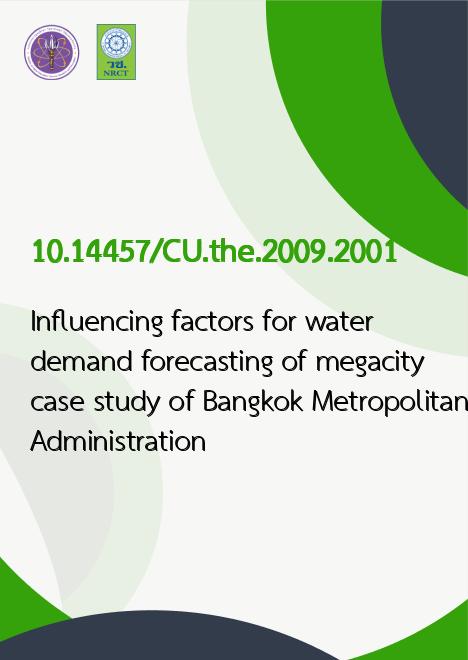
|
Influencing factors for water demand forecasting of megacity case study of Bangkok Metropolitan Administration |
|---|---|
| รหัสดีโอไอ | |
| Title | Influencing factors for water demand forecasting of megacity case study of Bangkok Metropolitan Administration |
| Creator | Wanpiya Phiw-ngam |
| Contributor | Thares Srisatit |
| Publisher | Chulalongkorn University |
| Publication Year | 2552 |
| Keyword | Water demand management -- Thailand -- Bangkok, Water consumption -- Thailand -- Bangkok, Water consumption -- Forecasting |
| Abstract | This research has analyzed all information of 8 factors which might influence to water demand consumption (Y) in Bangkok metropolitan area. All 8 factors are 1) Total population, X[subscript 1] (capita) 2) Total precipitation, X[subscript 2] (mm/year) 3) Size of family, X[subscript 3] (/capita/family) 4) Average selling price, X[subscript 4] (Baht/cu.m.) 5) Average temperature, X[subscript 5] (degree Celsius) 6) Income per capita, X[subscript 6] (Baht/capita) 7) Density of population per area, X[subscript 7] (capita/sq.km) 8). Budget of each district, X[subscript 8] (Baht/year). By separate study area in 3 sections 1) Inner area 2) Intermediate area 3) Outer area of Bangkok metropolitan. The aim of this study is to study the relation of water demand and all influence factors and to study the proper prediction, forecasting of water demand in megacity by using the influence factors. For the inner area, the relations of factors are in 3 groups (Group 1 = X[subscript 1], X[subscript 4], X[subscript 6]), (Group 2 = X[subscript 7], X[subscript 3], X[subscript 8]), (Group 3 =X[subscript 5], X[subscript 2]). The forecasting equation of inner area is Y[subscript inner] = 5.2x10[superscript -5] X[subscript 1] -3.1x10[superscript -3] X[subscript 2] +3.7x10[superscript -4]X[subscript 3] +1.782X[subscript 5] - 2.7x10[superscript -4] X[subscript 7] +3.1229. For the intermediate area, the relations of factors are in 3 groups. (Group 1= X[subscript 4] and X[subscript 6]), (Group 2= X[subscript 1], X[subscript 3], X[subscript 7], X[subscript 8]), (Group 3 = X[subscript 2] and X[subscript 5]). And The forecasting equation of intermediate area isY[subscript interim] = 3.93x10[superscript -5] X[subscript 1] -4.3x10[superscript -3] X[subscript 2] +3.62x10[superscript -4] X[subscript 3] +4.092X[subscript 5] -5.9x10[superscript -4] X7+1.35x10[superscript -7] X[subscript 8] + 4.556. For the outer area the relations of factors are in 4 groups. (Group 1 = X[subscript 4], X[subscript 6]), (Group 2 = X[subscript 2], X[subscript 5], X[subscript 8]), (Group 3 = X[subscript 1], X[subscript 3]), (Group 4 = X[subscript 7] ). And the forecasting equation of outer area is Y[subscript outer] = 3.93x10[superscript -5]X[subscript 1] -4.3x10[superscript -3] X[subscript 2] + 3.62x10[superscript 4] X[subscript 3] +4.092X[subscript 5] -5.9x10[superscript -4] X[subscript 7] +1.35x10[superscript -7] X[subscript 8] +4.36. As the result, the most of factors that influence to the water demand consumption in all three sections are number of population, amount of precipitation, average selling price and income per capita. But there are some factors which effect in individual section e.g. number of population in the inner area, density of population and budget of district in the intermediate and outer area. And their equations have forecast the water demand consumption in each area for next 10 years (2009-2019) will increase about 7-12% or total consumption will be 3.67 million cubic meters per day in 2019. |
| URL Website | cuir.car.chula.ac.th |